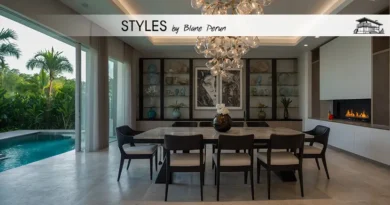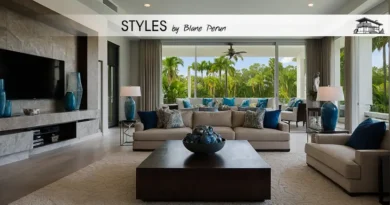Industrial Style
Unveiling the Charm of Industrial Interior Design: A Modern Twist on Classic Foundations
Industrial interior design has surged in popularity, bringing with it an appreciation for raw, unpolished elements that tell a story of history and resilience. This style, characterized by its use of exposed steel, distressed wooden elements, and sparse, functional furniture, has found its way from the lofty, expansive spaces of old factories and warehouses into our homes and offices. It’s a style that celebrates the beauty of the unfinished, making it uniquely adaptable and personal.

The Blueprint of Industrial Aesthetics
The Core Elements of Industrial Spaces
At the heart of industrial interior design is a palette of materials that exude an aura of strength and timelessness. Think exposed brick walls, concrete floors, and visible piping and ductwork. These elements not only pay homage to the industrial era’s architectural ingenuity but also add an authentic, gritty character to the space. Incorporating such raw materials requires an understanding of their properties and origins, like knowing that the scientific term for the rust that often adorns metal elements is iron oxide, which forms when iron reacts with oxygen and water.
Lighting: Illuminating with Purpose
Lighting in industrial design is more than just functional; it’s a statement. Large, metal pendant lights and floor lamps with Edison bulbs not only illuminate but also contribute to the overall aesthetic. The design principle here is to use lighting fixtures that look like they could have illuminated a factory floor in the early 20th century, thus enhancing the industrial vibe.
Infusing Modern Comforts
Furniture: Blending Form and Function
When it comes to furniture, industrial interior design leans towards pieces that are as practical as they are stylish. This is where the art of blending modern comforts with industrial aesthetics comes into play. Sofas and chairs often feature clean lines and are made of materials like leather and metal, offering comfort without sacrificing the industrial look.
Textiles and Accents: The Soft Side of Industrial
While industrial design might seem all about hard edges and cold materials, textiles play a crucial role in balancing the look. Rugs, cushions, and throws add warmth and texture, making the space more inviting. The use of natural fabrics like cotton and wool can soften the industrial feel without detracting from the overall theme.
Reinventing Industrial Spaces
The Evolution of Industrial Interiors
Industrial interior design is not static; it evolves by incorporating elements from various design trends while retaining its core characteristics. This adaptability makes it suitable for not just lofts and studios but also for commercial spaces like cafes and bookstores, where it can create a welcoming yet edgy atmosphere.
Sustainability in Industrial Design
In recent years, there’s been a push towards sustainability in interior design, and the industrial style is no exception. Reclaimed wood, recycled metal, and repurposed furniture are not only eco-friendly choices but also add to the authenticity and story of the space, adhering to the industrial ethos of utility and durability.
In embracing industrial interior design, we celebrate the beauty in the raw, the history in the aged, and the story in every scratch and dent. It’s a style that encourages us to find the elegance in the utilitarian and the cozy in the cavernous, bridging the gap between the past and the present in our living spaces.

FAQs about Industrial Interior Design
What makes industrial interior design unique?
Industrial interior design stands out for its embrace of raw and unfinished elements, such as exposed brick, metal, and wood. This style celebrates the beauty of imperfection and the stories these materials tell, blending historical authenticity with modern aesthetics.
How can I incorporate industrial design into a small space?
Even in smaller spaces, you can adopt industrial design elements by focusing on materials and colors. Use metal light fixtures, wooden furniture with a raw look, and maintain a neutral color palette with grey, black, and white tones to mimic the industrial aesthetic.
Is industrial design only suitable for urban lofts and apartments?
While industrial design originated in urban lofts, its principles can be adapted to various settings, including suburban homes. Key elements like metal accents, exposed beams, and minimalistic furniture can bring an industrial vibe to any space.
Can industrial interior design be cozy?
Absolutely! Despite its raw and rugged elements, industrial design can be warm and inviting. Soften the space with plush textiles, warm lighting, and personal touches like art and indoor plants to balance the industrial materials.
How does industrial design incorporate modern technology?
Modern technology can blend seamlessly into industrial interiors through thoughtful placement and choice of devices. Sleek, minimalist gadgets complement the design, while smart home technology can be integrated without disrupting the aesthetic, preserving the blend of old and new. Industrial interior design, with its blend of historical character and contemporary functionality, not only appeals to those looking to pay homage to the architectural achievements of the past but also to those who seek a dynamic and adaptable living space. This style’s ability to marry the raw and the refined, the old and the new, makes it a versatile choice for any interior space, be it a bustling urban loft or a cozy suburban home.
FAQs about Industrial Interior Design (Continued)
How do you balance the industrial and modern elements in a space?
Balancing industrial and modern elements requires a thoughtful approach to design. Start with a base of industrial materials like exposed brick and metal, and soften these with modern touches such as sleek furniture, contemporary art, and smart home technology. The key is in the juxtaposition—allowing each element to shine without overwhelming the other.
What are some common challenges when designing an industrial-style interior?
One of the main challenges is ensuring the space doesn’t feel too cold or impersonal, which can happen with an overemphasis on metal and concrete. To combat this, incorporate warm wood tones, soft textiles, and personal items that add warmth and character. Another challenge is maintaining the balance between open space and coziness, particularly in large, loft-like environments.
How can industrial design elements be made more sustainable?
Sustainability in industrial design can be enhanced by using reclaimed or recycled materials, such as wood from old buildings or metal from decommissioned factories. Additionally, incorporating energy-efficient lighting and appliances, as well as sustainable textiles, can further reduce the environmental impact of your industrial-inspired space.
What role does art play in industrial interior design?
Art plays a significant role in adding personality and depth to an industrial space. Large, bold pieces can serve as focal points and introduce color and texture. Industrial-themed art, such as architectural sketches or abstract pieces that mimic industrial materials, can reinforce the aesthetic while providing a personal touch.
Can industrial design elements be incorporated into outdoor spaces?
Yes, industrial design elements can be extended to outdoor spaces, creating a cohesive indoor-outdoor flow. Use materials like corten steel for planters and outdoor fireplaces, and incorporate concrete elements for seating or tables. Industrial-style outdoor lighting can also enhance the ambiance, making your outdoor space an extension of your interior design.
In conclusion, industrial interior design offers a versatile and dynamic approach to decorating that can be adapted to suit a wide range of spaces and personal tastes. By understanding the core elements of the style and how they can be modified to fit different environments, you can create a space that is both aesthetically pleasing and deeply personal. Whether you’re working with a vast loft space or a cozy corner of your home, the principles of industrial design can help you achieve a balance of form and function that is truly unique.





